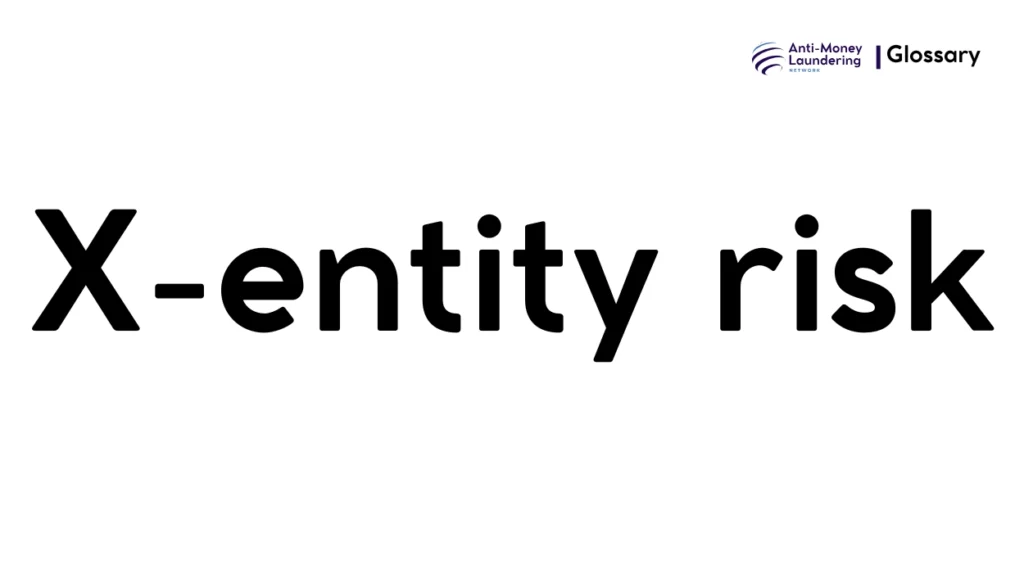Anti-Money Laundering (AML) compliance is critical for financial institutions and compliance officers to prevent illicit financial flows. Among various AML risks, “X-entity risk” is a crucial yet often specialized concept relating to entities that pose particular risks in laundering or terrorist financing. Let’s explore this term thoroughly for clarity and practical adherence.
Definition
X-entity risk in AML refers to the risk associated with certain legal or natural persons (entities) that have a higher potential to be involved in money laundering or terrorist financing activities. These entities might include corporate bodies, legal arrangements, or individuals whose characteristics, ownership structures, or behaviors raise suspicion or regulatory concern due to their risk profiles.
While “X-entity risk” is not universally codified as a single defined term across all AML laws, it functions as a category to encapsulate high-risk entities demanding enhanced scrutiny in AML compliance programs. It helps institutions identify and monitor entities that, because of their nature or activity, inherently carry a greater threat of misuse for illicit financial flows.
Purpose and Regulatory Basis
The purpose of defining and evaluating X-entity risk is to:
- Prevent financial crime by identifying potentially higher-risk corporate or individual entities.
- Ensure compliance with international AML frameworks.
- Protect financial systems and institutions from exploitation.
Key regulatory and guidance frameworks influencing this concept include:
- Financial Action Task Force (FATF) Recommendations: They set global standards requiring risk-based assessments that include identifying risky entities.
- USA PATRIOT Act: Expands customer due diligence, emphasizing entities’ beneficial ownership and risk profiles.
- European Union AML Directives (AMLD): Highlight enhanced due diligence requirements for high-risk entities and beneficial ownership transparency.
- National AML laws: E.g., Pakistan AML Act 2010, local rules requiring institutions to assess entity risks and conduct enhanced due diligence accordingly.
These regulations compel institutions to adopt systems and controls focusing on entities with suspicious or complex ownership, high-risk jurisdictions, or those engaging in unusual transaction behaviors.
When and How it Applies
Real-World Use Cases
Financial institutions apply X-entity risk assessments:
- At onboarding: When a corporate or individual entity requests accounts or services.
- During transaction monitoring: If an entity exhibits unusual transaction patterns.
- In risk profiling: When updating existing customer risk ratings.
Triggers and Examples
Triggers include:
- Complex ownership especially with nominee shareholders or opaque trusts.
- Entities incorporated in jurisdictions known for secrecy or poor AML regulation.
- Newly established companies conducting high-value or rapid transactions.
- Entities with connections to politically exposed persons (PEPs).
Examples:
- A shell company registered offshore conducting sudden large wire transfers.
- A trust with undisclosed beneficial owners linked to high-risk countries.
Types or Variants
X-entity risk covers a broad spectrum, often including:
- Shell Companies: Entities without active business operations, used to obscure ownership.
- Complex Legal Structures: Such as trusts or special purpose vehicles used to layer transactions.
- High-Risk Jurisdiction Entities: Incorporated in or operating from countries identified as high-risk by FATF.
- Entities Linked to PEPs: Persons with prominent public roles or connections increasing corruption risk.
Each type demands tailored AML scrutiny and controls.
Procedures and Implementation
To manage X-entity risk, institutions should:
- Conduct robust Customer Due Diligence (CDD): Verify identity, ownership, and source of funds.
- Apply Enhanced Due Diligence (EDD): For entities identified as high risk, deeper investigations into ownership and transactions.
- Deploy Transaction Monitoring Systems (TMS): Automated detection for suspicious entity activities.
- Maintain audit trails and documentation: For compliance and regulatory inspections.
- Train staff: Ensure awareness of entity risks and red flags.
- Integrate Risk-Based Approach: Continuous risk assessment, resource allocation according to entity risk.
Technologies such as AI and machine learning can aid in identifying complex or hidden entity risks.
Impact on Customers/Clients
Entities flagged for X-entity risk may experience:
- Additional documentation and verification requests.
- Transaction delays due to enhanced scrutiny.
- Potential account restrictions or closures if risks cannot be mitigated.
- Increased oversight of ongoing activities.
Customers retain rights under privacy laws but must cooperate with AML inquiries. Institutions must balance compliance obligations with customer service.
Duration, Review, and Resolution
- Duration: X-entity risk management is ongoing for the lifecycle of the customer relationship.
- Review: Regular reviews ensure that changes in ownership, behavior, or risk environment are addressed.
- Resolution: Risk may be reduced by mitigating controls or may lead to escalated reporting and possibly terminating business relations if unresolved.
Documenting reviews and decisions is essential for accountability.
Reporting and Compliance Duties
Institutions must:
- Report suspicious activities related to X-entities promptly to Financial Intelligence Units (FIUs).
- Keep extensive records of due diligence and investigations.
- Ensure compliance with all national and international AML requirements.
- Face penalties, including fines or sanctions, for failure to adhere to AML obligations.
Related AML Terms
X-entity risk is connected with several core AML concepts:
- Customer Due Diligence (CDD) / Enhanced Due Diligence (EDD)
- Know Your Customer (KYC)
- Suspicious Transaction Reporting (STR)
- Beneficial Ownership Disclosure
- Politically Exposed Persons (PEP)
- Transaction Monitoring and Red Flags
Understanding X-entity risk reinforces these relationships within AML frameworks.
Challenges and Best Practices
Challenges
- Identifying true beneficial ownership in complex structures.
- Avoiding excessive false positives that strain resources.
- Keeping pace with evolving entity typologies and regulations.
Best Practices
- Leverage advanced analytics and technology.
- Regularly train compliance personnel.
- Apply risk-based approaches tailored to institutional profiles.
- Engage in information sharing with regulators and peers.
Recent Developments
- Growing regulatory focus on transparency and ultimate beneficial ownership.
- Adoption of AI-driven risk-scoring models for entities.
- Enhanced cross-border cooperation to track illicit entity activity.
- Increased scrutiny on virtual assets and entities involved in crypto transactions.
X-entity risk is a vital AML concept involving entities that present higher threats of facilitating money laundering or terrorist financing. Through comprehensive identification, due diligence, monitoring, and reporting, institutions can mitigate these risks effectively, ensuring regulatory compliance and safeguarding financial systems against abuse.

